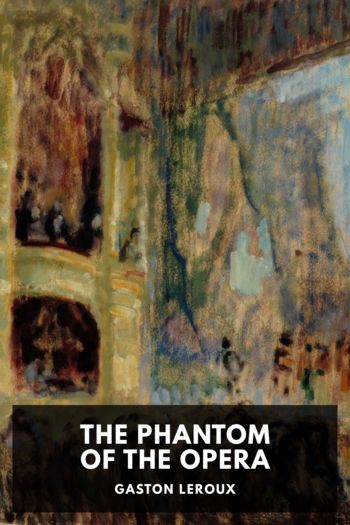The Phantom of the Opera by Gaston Leroux (classic books for 11 year olds txt) 📕

- Author: Gaston Leroux
Book online «The Phantom of the Opera by Gaston Leroux (classic books for 11 year olds txt) 📕». Author Gaston Leroux
This was the time of the rosy hours of Mazenderan, of which the daroga’s narrative has given us a glimpse. Erik had very original ideas on the subject of architecture and thought out a palace much as a conjuror contrives a trick-casket. The Shah ordered him to construct an edifice of this kind. Erik did so; and the building appears to have been so ingenious that His Majesty was able to move about in it unseen and to disappear without a possibility of the trick’s being discovered. When the Shah-in-Shah found himself the possessor of this gem, he ordered Erik’s yellow eyes to be put out. But he reflected that, even when blind, Erik would still be able to build so remarkable a house for another sovereign; and also that, as long as Erik was alive, someone would know the secret of the wonderful palace. Erik’s death was decided upon, together with that of all the laborers who had worked under his orders. The execution of this abominable decree devolved upon the daroga of Mazenderan. Erik had shown him some slight services and procured him many a hearty laugh. He saved Erik by providing him with the means of escape, but nearly paid with his head for his generous indulgence.
Fortunately for the daroga, a corpse, half-eaten by the birds of prey, was found on the shore of the Caspian Sea, and was taken for Erik’s body, because the daroga’s friends had dressed the remains in clothing that belonged to Erik. The daroga was let off with the loss of the imperial favor, the confiscation of his property and an order of perpetual banishment. As a member of the Royal House, however, he continued to receive a monthly pension of a few hundred francs from the Persian treasury; and on this he came to live in Paris.
As for Erik, he went to Asia Minor and thence to Constantinople, where he entered the Sultan’s employment. In explanation of the services which he was able to render a monarch haunted by perpetual terrors, I need only say that it was Erik who constructed all the famous trap-doors and secret chambers and mysterious strongboxes which were found at Yildiz-Kiosk after the last Turkish revolution. He also invented those automata, dressed like the Sultan and resembling the Sultan in all respects,13 which made people believe that the Commander of the Faithful was awake at one place, when, in reality, he was asleep elsewhere.
Of course, he had to leave the Sultan’s service for the same reasons that made him fly from Persia: he knew too much. Then, tired of his adventurous, formidable and monstrous life, he longed to be someone “like everybody else.” And he became a contractor, like any ordinary contractor, building ordinary houses with ordinary bricks. He tendered for part of the foundations in the Opera. His estimate was accepted. When he found himself in the cellars of the enormous playhouse, his artistic, fantastic, wizard nature resumed the upper hand. Besides, was he not as ugly as ever? He dreamed of creating for his own use a dwelling unknown to the rest of the earth, where he could hide from men’s eyes for all time.
The reader knows and guesses the rest. It is all in keeping with this incredible and yet veracious story. Poor, unhappy Erik! Shall we pity him? Shall we curse him? He asked only to be “someone,” like everybody else. But he was too ugly! And he had to hide his genius or use it to play tricks with, when, with an ordinary face, he would have been one of the most distinguished of mankind! He had a heart that could have held the empire of the world; and, in the end, he had to content himself with a cellar. Ah, yes, we must needs pity the Opera ghost.
I have prayed over his mortal remains, that God might show him mercy notwithstanding his crimes. Yes, I am sure, quite sure that I prayed beside his body, the other day, when they took it from the spot where they were burying the phonographic records. It was his skeleton. I did not recognize it by the ugliness of the head, for all men are ugly when they have been dead as long as that, but by the plain gold ring which he wore and which Christine Daaé had certainly slipped on his finger, when she came to bury him in accordance with her promise.
The skeleton was lying near the little well, in the place where the Angel of Music first held Christine Daaé fainting in his trembling arms, on the night when he carried her down to the cellars of the opera-house.
And, now, what do they mean to do with that skeleton? Surely they will not bury it in the common grave! … I say that the place of the skeleton of the Opera ghost is in the archives of the National Academy of Music. It is no ordinary skeleton.
EndnotesI have the anecdote, which is quite authentic, from M. Pedro Gailhard himself, the late manager of the Opera. ↩
Flash notes drawn on the “Bank of St. Farce” in France correspond with those drawn on the “Bank of Engraving” in England. —Translator’s note ↩
M. Pedro Gailhard has himself told me that he created





Comments (0)